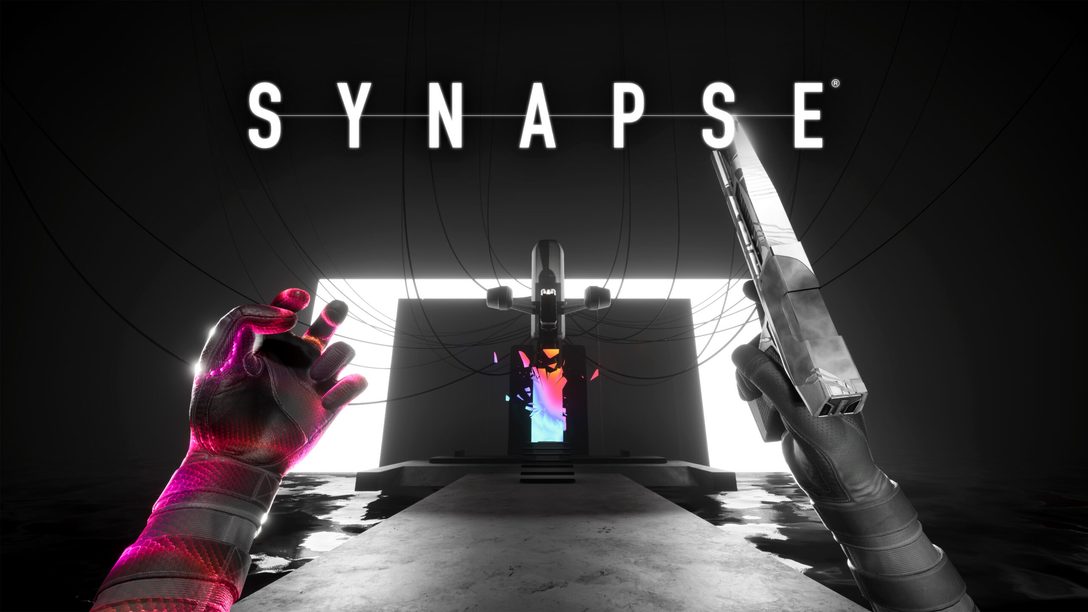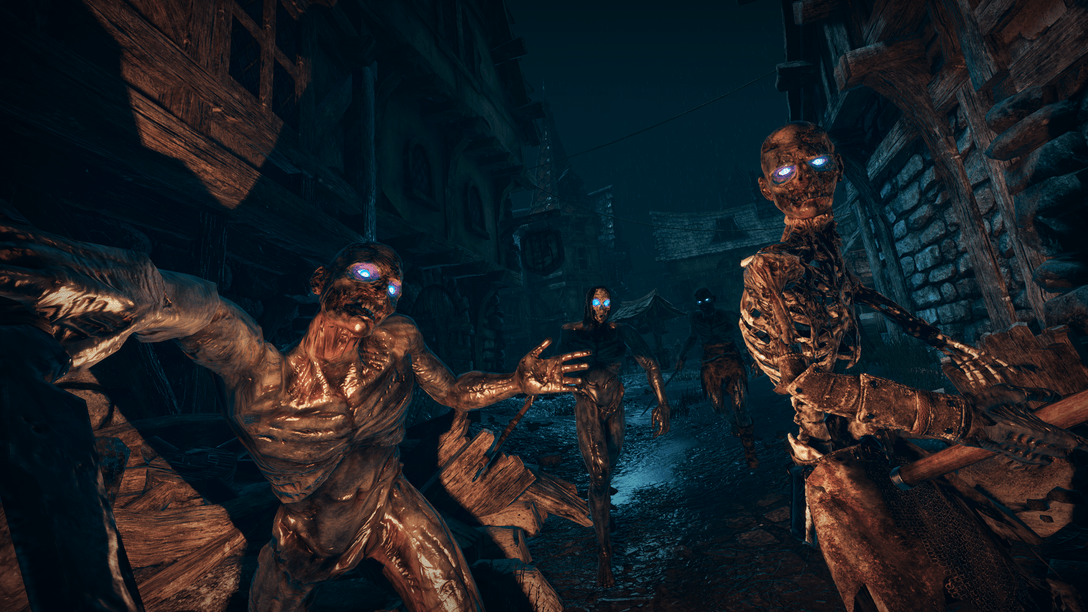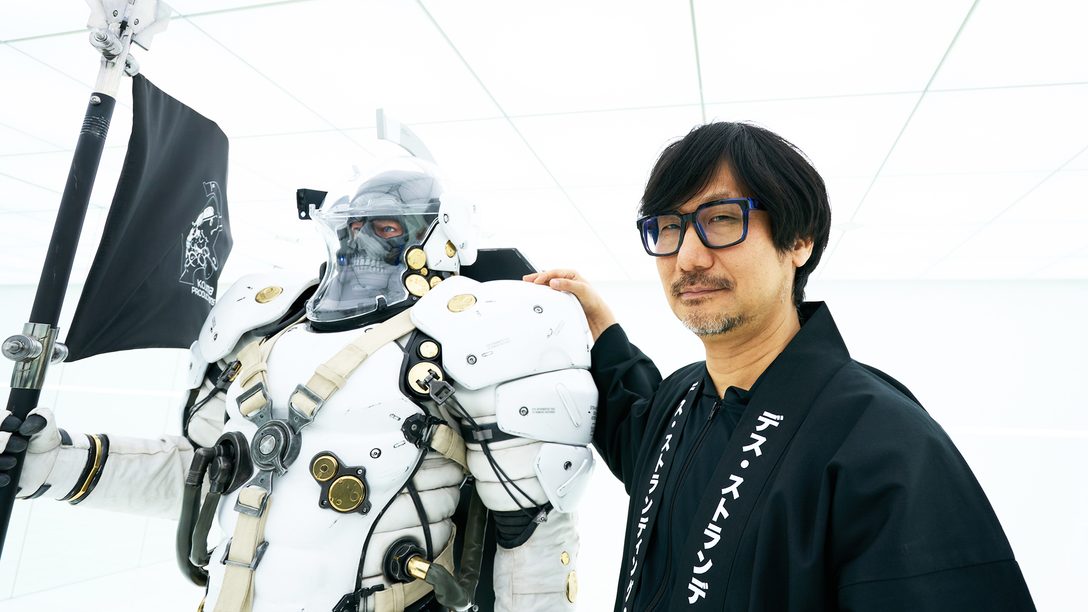
With a roguelite structure and compelling power sets, nDreams is crafting a beautiful and fun VR experience launching July 4.
Synapse’s State of Play reveal illustrated a potent combo of sidearm and telekinetic-infused combat. Last month at PlayStation Showcase, developer nDreams used the release date announcement to dig into the story of a lone operative diving into another’s mind to avert global catastrophe, and the reunion of two high-caliber voice talents who find themselves again involved in a black ops-style mission, but this time on different sides of a battlefield. And now, thanks to a hands-on with a specially-curated playable demo, we have a better understanding of how Synapse gameplay unfolds.
Let’s break down the core gameplay loop. It’s driven by tactical combat, using your base abilities of bullets and TK plus interactive objects to clear out multi-leveled arenas of enemies. Those encounters are punchy bursts of action which increase in complexity and intensity. You’re outnumbered, continually outflanked, attackers able to short-range teleport to better position themselves. The odds are put back in your favor through steadily unlocked abilities and randomized buffs, all tools built to nudge you into being as enjoyably, efficiently creative with your skills as possible. Synapse has the DNA of a roguelite.
Let’s dig deeper. A run will have you fight a growing mix of enemy types across multiple levels, the sequencing of those stages randomized and pulled from a large pool of potential locations. Completion of any opens a door to the next, at the threshold of which you’re offered one of two possible two Traits. These add fun modifiers for the rest of your run. Clutch an object with TK to kick in slo-mo. Add a curve to your bullets. Turn TK-grabbed foes into short-term friendlies or targets for other assailants to draw fire away from you.

Synapse’s mini-map is thoughtfully executed. Flip your TK hand palm up for a radial-style device to materialize upon it. A 3D space floats above it, pinpoints enemy locations and collectables. It’s an interaction with the same simple satisfaction – and muscle memory – as checking your watch for notifications.
Revelations is Synapse’s name for permanent upgrades split across three skill trees, for your TK, weapons and general resilience respectively. These trees are available between runs and will grant you, amongst others, the ability to grab enemies (and toss them around like rag-dolls) or their grenades (catching them mid-throw), increase your weapon loadout. You can activate Shrines that’ll spawn within levels, granting you a health boost or new weapons.
All are unlocked and used during my hands-on, early access granted thanks to a generous dose of XP (called Defiance in Synpase) for the purposes of the demo. But before I step into several arenas to play around with my powers, I need to learn how the core mechanics work. Cue tutorial and the base mechanics.
Movement is an uncompromised first-person shooter, character movement and camera operated by the Sense controller sticks, with comfort settings also offered. You can also pick which of your hands does what. Gun hand is
is self-explanatory but doesn’t work in isolation: guns need to be reloaded by way of partially ejecting them then slamming magazines back into position. You can use your other hand. Or any solid surface, which includes cover points and an enemy’s noggin. Reloads continue to feel satisfying throughout the run.
Your other hand is where multitasking takes off. It can be used to grab cover, your Sense controller movement mirrored in-game to pull you out, up or to the side of whatever you’re ducking behind. As long as you’ve got your finger pulled down on the Sense controller trigger, you’re anchored. It’s a design brought over from nDreams’ previous PS VR title Fracked. A nice feature that gives you mobility options while stationary.

The game’s music is being scored by Paul Weir, who also composed No Man’s Sky. The direction he was tasked to draw inspiration from was the cerebral blockbuster movies of Christopher Nolan, lending a Zimmer-like soundtrack to Synapse.
It’s this hand, along with PS VR2’s eye-tracking, that powers TK. You learn very quickly what is interactive in Synapse: crates, platforms (and later, enemies and their grenades). In a world that’s wholly monochrome, objects made for manipulating are suddenly outlined in vibrant color. Grip with the Sense controller, and you’re free to shift the item as telekinesis intended.
The item’s movement and velocity is dictated by your hand’s movement and speed. Hold a crate steady and close, and you have mobile cover. You could toss a fastball and use this flying box to cannon into – and aimed right, one-shot kill – enemies. The delicacy and precision that TK physics offers is impressive. I’ll admit I spend longer in the tutorial than I need to, just carefully stacking crates or attempting to juggle three in the air, spinning each faster and faster as I catch and release them, tossing them higher and higher.


Two examples of using TK during combat: crates can be held and swiped back and forth, knocking enemies down like skittles. Barrels can be an explosive way to take out foes well hidden behind cover.
There’s smart use of the Sense controller’s adaptive triggers as well, with volatile objects such as barrels and live grenades requiring a lighter grip if you’re to hold them safely. Pull fully on the trigger and you’ll crush them, leading to explosive results. Perfect to toss then squeeze as they arc over the heads of congregating shooters, though a stray bullet from either side can as easily ignite a barrel.
Even in these early encounters, the action ramps up quickly, requiring you to think even quicker, pinpointing possible configurations of useful items, enemy locations, your route through and around any danger. All familiar ingredients of a roguelite, but TK gives Synapse a unique flavor.
And I’d be remiss if I didn’t take the time to acknowledge Synapse’s art direction. Monochrome levels with pops of vibrant color initially echo the best showroom OLED TV demos in showrooms, but the more I took time to soak in my surroundings, the more I felt subtly unsettled. The studio points out surrealistic art as an initial inspiration, but I realized what the desolate shoreline and rocky outcrops of this first biome was reminding me of. It’s a black and white starkness that harkened the setting of Swedish fantasy film The Seventh Seal. In that, a knight plays for his life in a game of chess against Death.
Perhaps that parallel isn’t an accident. Synapse’s story is one built around a battle of wits between two minds: The Colonel and his invader’s. In actual fact, it’s three different sources: the Colonel’s mind, your character’s own and the AI in control of the system. I’m curious to see what unfolds visually. nDreams promises a strong narrative to pull you in, stating it’ll take three complete runs to uncover the full scope of its story. And even after its conclusion, the game’s roguelite design is built to entice you back into another mind dive.











Comments are closed.
8 Comments
Loading More Comments